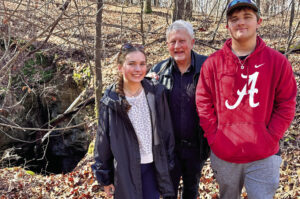Modern day monsters that can eat you – really!
By Staff
June 22, 2001
There lives in the mountains and valleys of the west a life form that mimics the dreams and creations of Hollywood's most extreme producers of science fiction movies. You know, the ones with giant apes that smash cities; bees that swarm over the earth in clouds stinging every living thing.
Such a spooky entity really exists and its dangers are held in check only by its limited range. In fact, in 1848, millions of these beasts descended on Mormon settlers in Utah, destroying their crops, biting anyone who got in their way and threatening to force the population to leave their homesteads for safer farmland.
The beast has a menacing name, Orthoptera Tettigoniide Anabrus simplex. Its common name is Mormon cricket. How could a lowly cricket be so dangerous, you might ask. Well, first of all it isn't a cricket. Welcome to the world of misnomers in the field of science. It was called a cricket by the Mormons and others because it looks like a cricket and acts like a cricket. It's really a plant-eating grasshopper. Big deal, you say. Okay, but at least we have that cleared up. And if it hadn't been a grasshopper I may not have been assigned by the Department of Agriculture to track down vast bands of the destructive insects and do them in.
Mean Babies
The beasts begin life as soon as the snow melts in spring by hatching from the ground in numbers that are typically 900 per square yard. They are about the size of fleas at first, but they are born with strong mandibles (teeth) and can bite and draw blood even as infants. They begin to grow immediately and spread out to get elbow room. They molt 7 times, bursting forth into larger bodies each time, ending up in August about 2 inches long and with bigger and stronger teeth.
After a couple of molts, they strangely begin to migrate across the countryside, all traveling in the same direction. Yes, miles of these creatures creep and skip along all going in one direction just like the animated swarms in the movies. At night they climb sagebrush bushes to roost. In the morning they all climb down and strike out in the same direction, those in the huge band perhaps miles away all somehow knowing which way to head.
Because there isn't much to eat in the Rocky Mountain high country, they have adapted to eat almost anything that can be chewed there, including sagebrush, grass, weeds bark on trees or fence posts. Cultivated crops and the tender body parts of campers or hikers are delicacies. Picture an entire mountain scene around your campsite covered in big, black creepers at a dozen per square yard all interested in feeding on your flesh. This can be inconvenient.
They will eat the paint off a house if they are hungry and a house happens to be in their migrating path. Nothing stops their seasonal 20 mile march. They go straight up mountain cliffs and pour over the top by the millions in scenes that chill ones' blood.(None of this is fiction – it's all in the books if you want to check). I have built a campfire and watched members of a migrating band hop right into the flames to their death as they veered neither right nor left for elbow room, surging straight ahead as if drawn by a magnet.
Instant Snacks
Just in case they find nothing to eat in their path, no problem, they have a standby survival habit. They eat each other! Yes, this instinct shows up in their early life stages. The weak ones are dined on first. If you want to see for yourself, pick up one (keep fingers away from the mouth end) pull off a leg and toss him back into the crowd. His companions will see his disability and immediately cannibalize him, as many as can grab hold. If they are not too hungry, they will leave the hard, crusty legs. Otherwise the injured cricket will completely disappear in about 30 seconds.
Twice I have seen bands of Mormon crickets 7 measured miles wide. The length of these bands is unknown, but probably several times the width because they cross a given point sometimes for weeks. When they cross roads, traffic squishes them until the roads become slick and dangerous. Even dirt roads can become so clogged that drivers of the first automobiles in the early 1900's reported sliding into ditches. That's a lot of squished insects!
When these minute monsters descended into the great Salt Lake basin in the mid-1800's, the Mormons prayed for relief. Large flocks of seagulls subsequently appeared in the sky (now this is Utah remember) and they ate Mormon crickets by the billions. The depleted bands retreated into the mountains where they exist in varying numbers to this day in several western states. The seagulls stayed around and still inhabit the Salt Lake area. For their celebrated arrival, a monument to the seagull stands today near the Mormon Temple.
(Note: Anyone who would like to see this natural phenomenon should contact the National Park Service at Dinosaur National Monument in Dinosaur, Colorado – a most likely area for high populations of Mormon crickets or the state extension service at the agricultural universities in Colorado, Utah or Nevada. The time to find impressive bands is August.)










